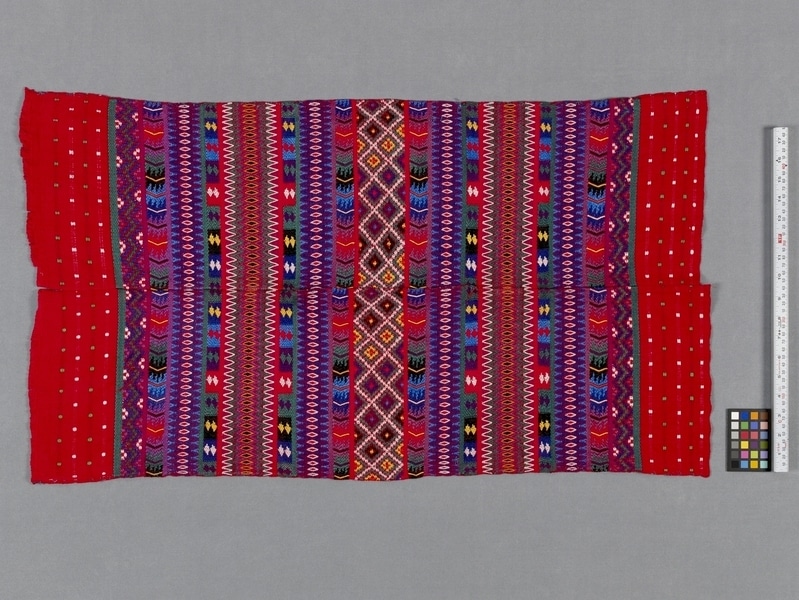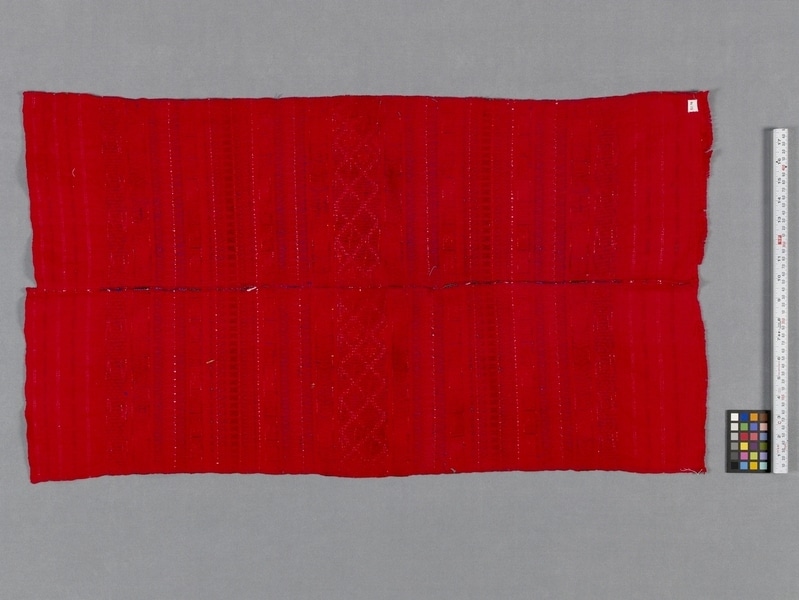Blouse Item Number: Sa173 from the MOA: University of British Columbia


Description
Blouse composed of two rectangular woven red panels with white and green dots sewn together with an slit left unsewn at the centre to form the neck hole. The blouse is decorated with horizontal bands of multicoloured brocaded geometric designs.
History Of Use
Most likely a newer huipil, since the warp and weft are red. Older huipiles in San Antonio Aguas Calientes have a dark blue warp and weft. A mosquito pattern is at the bottom on any San Antonio huipil, and can be seen on this particular one. The following traditional patterns are also found on this huipil : pie de cucho, dog foot; arco, arch; and archo de espinas, thorny arches (Bjerregaard).
Cultural Context
domestic
Narrative
This object forms part of the Inge Ruus Collection of Guatemalan Textiles in the Museum of Anthropology. The Inge Ruus Collection of Guatemalan Textiles was collected on behalf of the Museum of Anthropology by Inge Ruus, Curatorial Assistant in the Museum from 1974 to 1978. Some items were purchased by the Museum and others were donated by Inge Ruus. Inge Ruus collected these materials while attending courses on Guatemalan textiles in Guatemala during the summers of 1976 and 1977, taught by Anne Lambert, instructor on textiles at the University of Alberta.
Specific Techniques
Huipil made from one 26 cm wide 4-selvedge length that has been cut in half laterally and joined together along the lengthwise selvedge edges. Probably backstrap loomed warp faced plain weave ground fabric. Warp: 2 singles (s-plied); weft: two 2-plied threads (each s-plied) and four 2-plied threads (each s-plied). Woven with bands of edge-to-edge geometric patterning throughout, in continuous single-faced supplementary weft patterning over 2 to 6 warps. Supplementary weft: three 2-plied (s-plied) threads. Machine sewn front and back centre seams, head-hole created by break in stitching. Appears to have been previously machine stitched along side seams. One lower edge of the huipil features warp-end selvedge edges, the other a cut edge.
Item History
- Made in San Antonio De Aguas Calientes, Sacatepequez, Guatemala before 1976
- Collected by Inge Ruus
- Owned by Inge Ruus before July 1976
- Received from Inge Ruus (Seller) and Museum of Anthropology Donations Fund (Funding source) during July 1976
What
- Name
- Blouse
- Identification Number
- Sa173
- Type of Item
- blouse
- Material
- cotton fibre
- Manufacturing Technique
- dyed, woven and sewn
- Overall
- height 88.0 cm, width 50.0 cm
Who
- Culture
- Cakchiquel
- Field Collector
- Inge Ruus
- Previous Owner
- Inge Ruus
- Received from
- Inge Ruus (Seller) and Museum of Anthropology Donations Fund (Funding source)
Where
- Holding Institution
- MOA: University of British Columbia
- Made in
- San Antonio De Aguas Calientes, Sacatepequez, Guatemala
When
- Creation Date
- before 1976
- Ownership Date
- before July 1976
- Acquisition Date
- during July 1976
Other
- Item Classes
- textiles
- Condition
- good
- Accession Number
- 0318/0007 b